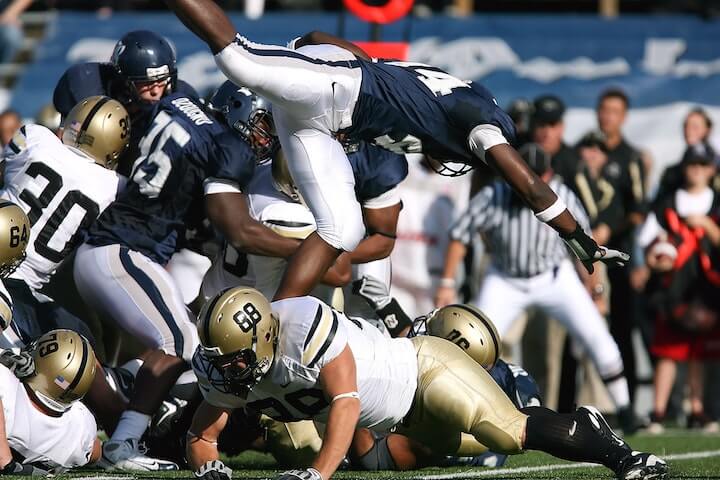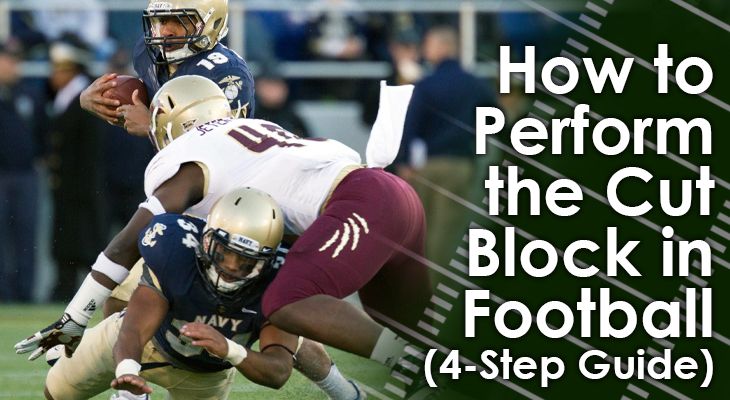A cut block often gets a bad rap in football.
This is mainly because it's a block that targets a defensive player's lower half, while most other blocks will have offensive linemen initiate contact with the opponent's upper body.
A cut block has them initiate contact below the defender's waist.
This makes it tricky on two fronts:
(1) It has the potential to cause a major injury to the defensive player if not done properly.
(2) Because of this, many football leagues have made only limited versions of the cut block legal.
It's easy for offensive players to execute it incorrectly, which could then result in an injury to a defensive player and/or a penalty called on them.
When done properly, however, it can be a great tool for offensive players.
By upending the defender and quite literally taking them off their feet, a well-executed cut block can open up huge running holes for the offense.

Rules For a Cut Block
There are rules that determine whether a cut block is legal.
A cut block is only legal if...
- It happens within five yards of the original line of scrimmage; AND
- The contact comes from the front; UNLESS
- Done by an interior offensive lineman (a guard or center)
In all other instances, it's deemed illegal.
This means that all offensive players except for the offensive guards and center must initiate a cut block from the front of a defender's legs.
Even guards and centers are not allowed to do this unless they are at the line of scrimmage, too.
There is also one other important exception to this rule...
If a cut block becomes a chop block, then it is also illegal.
Wait, What's a Chop Block?
A chop block is a variation of the cut block with one important distinction. ..
It involves an offensive player performing it on a defender who's already engaged in contact with another offensive player.
To understand this, picture an offensive guard blocking a defensive tackle.
While the guard is engaging contact with the defensive tackle, no other offensive player can perform a cut block on him.
In other words, the center next to the guard can't initiate contact below the defensive tackle's waist while the tackle is engaged with the guard.
This is an extremely dangerous play, as it makes the defender susceptible to a major injury.
That's why this version is actually called a chop block and is illegal at all levels of the game.
In fact, a penalty for a chop block (15 yards) is more serious than a penalty for an illegal cut block (5 or 10 yards, depending on the level of football).

How to Perform a Proper Cut Block
Now that you know what you can't do...
Here's how you can perform a this kind of block in football properly.
1. Step Toward the Defender
The offensive lineman's first step should be toward the defender.
If the defender is right in front of him, then he should explode forward.
If he's lined up over either of his shoulders -- or heads up on the offensive lineman next to him -- then his first step should jab on a diagonal toward the defender.
2. Stay Low
When the offensive lineman explodes out of his stance, he must stay low.
He shouldn't explode up and out of his stance, but rather just straight out.
3. Lunge Toward the Defender's Lower Half
After the first step, the offensive lineman should burst forward to make first contact with the defender's lower body.
He should aim just below the waist but above the defender's knee.
This is the aim point for two reasons:
First, aiming directly at a defender's knee can cause a lot of damage to the defender.
And second, aiming too low (at his feet, let's say) makes it easier for the defender to step back and avoid the block.
If this happens, the defender can leap over the offensive lineman, taking him out of the play completely.
Aiming the contact at the mid-thigh of the defender will force him to the ground and take the defender out of the play.
Step 4: Turn Your Body
After initial contact, the offensive player should turn his body.
This will continue the motion through that initial contact, and hopefully force the defender down to the ground.
In many cases, the initial hit won't knock the defender down. It'll just serve to knock him back and knock him off balance a bit.
The final turning motion will follow through and knock the defender to the ground.
Conclusion
If done properly, the cut block can be an extremely effective technique that opens up huge holes for ball carriers.
However, it's a little challenging to execute.
What's more, it can be a very dangerous play if it's not done correctly.
Hitting a defensive player directly on the knees or from the side can result in a devastating injury -- which is not the aim of this block.
It's also very easy for offensive players to commit a foul when trying to execute a cut block.
That's why it's very important to teach offensive players the proper technique to execute a cut block and practice it over and over again.

